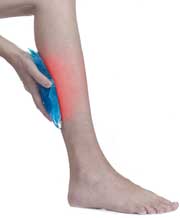Cryotherapy
Top Contributors - Neha Duhan, Garima Gedamkar, Francky Petit, Abbey Wright, Kim Jackson, Venus Pagare, Reece Black, Kale Schneider, WikiSysop, Uchechukwu Chukwuemeka, Claire Knott, Peyton Cooper and Admin
Definition/Description[edit | edit source]
Cryotherapy, also known as ice application, is the simplest and oldest way to treat injuries. Its worldwide use spread because of its effectiveness, convenience, low cost and ease of transportation. Ice is believed to control pain by instigating local anaesthesia. It also decreases oedema, nerve conduction velocities, cellular metabolism and local blood flow. The effect of the cryotherapy depends on the method, the duration, temperature of the ice and the depth of the subcutaneous fat. [1][2]
Application Methods[edit | edit source]
The most common method of cryotherapy is the use of ice packs. There are different types of ice used in ice packs. The most common types are ice packs made with cubed, crushed and wetted ice.[2] It was discovered that wetted ice is better to lower surface temperature during treatment and maintaining the lower temperature during recovery. It is also more effective in lowering the intramuscular temperature during treatment.[2]
A cooling effect can also be produced by icing spray for a similar effect.[3]
More recently whole body cryotherapy has become popular for athletes, to help aid recover, as well as in persistent pain patients such as rheumatological conditions. More research is needed to understand the effect on the body and its relation to pain.[4]
Conditions treated[edit | edit source]
- Acute soft tissue injuries e.g. ankle sprain, muscular strain
- Post orthopaedic surgery e.g. TKR, ACL reconstruction, arthroscopic shoulder surgery.[5]
- Acute sports injuries
- DOMS[3]
Benefits[edit | edit source]
- Pain relief[6]
- Swelling reduction[6]
- Decreased surface temperature
- Effective on a wide range of soft tissue injuries
Negatives[edit | edit source]
- Little evidence regarding duration and frequency of treatment to be effective[6]
- Compression has been shown to be more effective post operatively[6]
- In rare cases bradycardia and frostbite symptoms have been observed. [3]
- Some more advanced cryotherapy devices can reduce range of movement following TKR due to immobilisation of the joint. [7]
Resources[edit | edit source]
- ↑ Bleakley C, McDonough S, MacAuley D. The use of ice in the treatment of acute soft-tissue injury: a systematic review of randomized controlled trials. The American journal of sports medicine. 2004 Jan;32(1):251-61.
- ↑ 2.0 2.1 2.2 Dykstra JH, Hill HM, Miller MG, Cheatham CC, Michael TJ, Baker RJ. Comparisons of cubed ice, crushed ice, and wetted ice on intramuscular and surface temperature changes. Journal of athletic training. 2009 Mar;44(2):136-41.
- ↑ 3.0 3.1 3.2 Galiuto L. The use of cryotherapy in acute sports injuries. Annals of Sports Medicine and Research. 2016;3(2):1060.
- ↑ Banfi G, Lombardi G, Colombini A, Melegati G. Whole-body cryotherapy in athletes. Sports medicine. 2010 Jun 1;40(6):509-17.
- ↑ Ni SH, Jiang WT, Guo L, Jin YH, Jiang TL, Zhao Y, Zhao J. Cryotherapy on postoperative rehabilitation of joint arthroplasty. Knee Surgery, Sports Traumatology, Arthroscopy. 2015 Nov 1;23(11):3354-61.
- ↑ 6.0 6.1 6.2 6.3 Hubbard TJ, Denegar CR. Does cryotherapy improve outcomes with soft tissue injury?. Journal of athletic training. 2004 Jul;39(3):278.
- ↑ Thienpont E. Does advanced cryotherapy reduce pain and narcotic consumption after knee arthroplasty?. Clinical Orthopaedics and Related Research®. 2014 Nov 1;472(11):3417-23.







